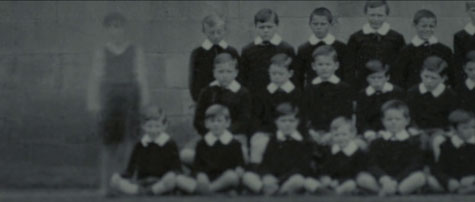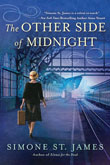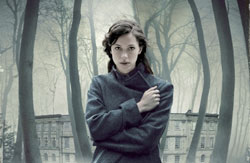
OBSERVATION: Between 1914 and 1919 war and influenza have claimed more than a million lives in Britain alone.
CONCLUSION: This is a time for ghosts.
Florence Cathcart (The Awakening)
Some things are inherently, across the board, creepy. Antique wheelchairs; derelict buildings—especially when they were once grand homes that loom over the landscape; nursery rhymes—doubly so when sung by small children; sepia-toned photographs of unsmiling families standing stiffly posed; old, threadbare toys.
There's just something about the relics of the past that unnerves us. Maybe it's the musty smell, the very tangible evidence of how time brings about death and decay, or the knowledge that the people in those pictures, who lived in those buildings, who once played with those toys, have long since been buried. Buried—but perhaps not entirely gone…
The past is always evocative. A story set in a bygone period can invoke an atmosphere impossible to achieve in a contemporary setting. There's a built-in melancholia and nostalgia; the ornate, often harsh trappings of that time provides disquieting props and unsettling set-dressings.
So, it's no surprise that some of the most compelling and frightening ghost stories unfold against a historical backdrop. And while there are hundreds of chilling novels and movies set in England's Victorian Age, when public grief was not only a way of life but a national obsession, I wanted to shine a light on some worthy tales set in another ghost-plagued period—the aftermath of the First World War.
In the years following what was then called The Great War, spiritualism—previously denounced and debunked by the new age of science and rationalism—experienced a huge resurgence in popularity. Families desperate to find closure turned to mediums and psychics, hoping to connect with the thousands of husbands, sons, and brothers who had disappeared in the trenches. Once bustling cities felt emptied while hospitals were bursting with the maimed and shell-shocked. An entire generation had essentially been wiped off the map, and the scars of war could be seen at every turn.
 Fertile ground indeed for ghosts. When it comes to fiction, author Simone St. James has effectively claimed this period in history as her own. Her novels—The Haunting of Maddy Clare, An Inquiry Into Love and Death, Silence for the Dead, and The Other Side of Midnight—are simultaneously elegies on The Great War and compelling ghost stories.
Fertile ground indeed for ghosts. When it comes to fiction, author Simone St. James has effectively claimed this period in history as her own. Her novels—The Haunting of Maddy Clare, An Inquiry Into Love and Death, Silence for the Dead, and The Other Side of Midnight—are simultaneously elegies on The Great War and compelling ghost stories.
As historical fiction, every detail rings true. St. James's characters are products of their time and circumstances, each one touched in some way by the shadow of the War. There are scarred veterans struggling with PTSD, temps desperate for work and willing to lie to secure a job, nurses and ghost-hunters, detectives and traitors. Every character is flawed, makes mistakes, has secrets in their past, and therefore, they feel like people you know and can understand.
The books resonate with loss and pain, but also with the hope of recovery and the possibility of rebuilding. Former soldiers move towards acceptance and healing. One narrator is among the first women to attend Oxford. Recurrent themes in St. James's work are that wrongs can be righted and victims can attain peace, even after death.
St. James's prose can be lyrical and moving, but she also knows when to be blunt and straightforward. This is what truly makes her novels of ghosts and violence so powerful and, yes, terrifying. When her characters are faced with the monstrous or unbelievable, the scenes are written in a way that makes them feel very real, very present, and very plausible. The most mundane details lend a sharp edge of surrealism. The ghostly horrors are precisely described and emerge fully-formed in the reader's imagination.
It's a rare book that can make me anxious. The author has to be doing a superb job to keep me from detaching. I'm wholly unashamed to admit that St. James can make me hide under the covers and jump at the slightest sound.
When the rotting hand presses against the window in An Inquiry Into Love and Death; when the long-dead servant girl appears at the foot of the stairs in The Haunting of Maddy Clare with arms too long and eyes too big—these are proper ghost stories, just the thing for a dark night or rainy day. They’re stories to prickle your spine or coax goose bumps across your arms.
The build-up to each climax is expertly handled, the clues and details carefully layered on until the horror hits its crescendo and the full mystery is unraveled. As the narrators uncover more about the past, so does the reader. Even the red herrings or seemingly extraneous details add to the tension and character development. St. James writes books that read like movies.
I would say that I wished St. James's books had been optioned by a movie studio, but The Awakening (2011) already exists. No, it's not an adaptation, but it's as close to one as we're likely to get.
 Florence Cathcart (Rebecca Hall) is a professional debunker who refuses to believe in the afterlife. She's unmasked too many charlatan psychics, exposed too many fraudulent séances and bogus hauntings. She understands the pain of those swindled by the fakes—she, too, lost someone to the War.
Florence Cathcart (Rebecca Hall) is a professional debunker who refuses to believe in the afterlife. She's unmasked too many charlatan psychics, exposed too many fraudulent séances and bogus hauntings. She understands the pain of those swindled by the fakes—she, too, lost someone to the War.
But she's determined to assert rationality over the rampant spiritualism affecting the country in the wake of the War—until she finds herself facing a job that may test all of her hard-earned convictions.
There's been a suspicious death at a remote boarding school—a young boy has suffered a fatal heart attack and the other students are insisting he was frightened to death by the resident ghost. Florence arrives with her debunking tools and sets right to work, but her assurance is almost immediately challenged.
Sparks flare between her and the teacher (Dominic West) who hired her, a former soldier struggling with his own demons. She begins to see things out of the corner of her eye and finds herself dwelling on her own long-repressed pain. She's plagued by an old nursery rhyme she can't get out of her head and slowly realizes that the vast, echoing boarding school feels strangely familiar.
The Awakening is a masterfully-done ghost story that can definitely be classified as horror—there are some incredibly frightening moments, and the tension is sometimes so taut you could swear your heart's about to burst—but it's also an emotional personal drama about belief, trauma, and breaking cycles of violence. The commentary on war and abuse is powerful, and the performances, particularly from Hall, West, and Imelda Staunton as the school's matron, are riveting.
This is a film that's low on budget but dripping with atmosphere. There's very little in the way of special effects but this is a story that doesn't need them; The Awakening understands that sometimes the most haunting things happen off-screen and in your own imagination. With its layered characters, ghostly focus, slowly unfolding mystery, and gut-punch of a climax, it's the perfect cinematic companion to Simone St. James' novels.
And it's proof that the past—with its unsettling nursery rhymes, echoing rooms, and faded photographs—can be just as frightening as a spectral face in the window.
Angie Barry wrote her thesis on the socio-political commentary in zombie films. Meeting George Romero is high on her bucket list, and she has spent hours putting together her zombie apocalypse survival plan. She also writes horror and fantasy in her spare time, and watches far too much Doctor Who. Come find the angie bee at Tumblr.

I’ve always loved both The Awakening and Simone St James and the similarities between the two are so striking! It’s hard to find others who have read/watched both so I”m glad I’m not the only one who noticed this!